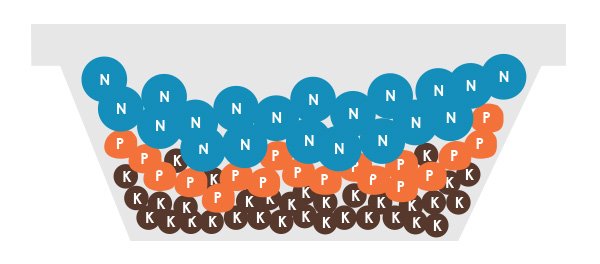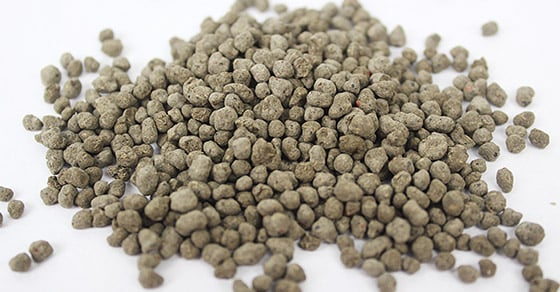When it comes to solid fertilizers, growers are often faced with the choice between complex fertilizers and fertilizer blends.
While fertilizer blends have long been the industry standard simply because they were the only multi-nutrient option available, complex fertilizers have become the preferred choice in many cases – a fact exhibited in a recent forecast by Markets and Markets. According to the firm, a healthy 6.5% CAGR is expected from 2017 to 2022, settling on a 54.32 Billion USD market value (up from 44.03 Billion in 2016).
The growth can likely be attributed to the many advantages complex fertilizers can offer over blends – most notably when it comes to promoting uniform nutrient distribution on fields.
Complex vs. Blend: What’s the Difference?
In some ways complex fertilizers and blends are similar; they both provide a multi-nutrient solution; both can incorporate additional micronutrients or other components into the formulation; and they can both be applied with standard spreaders.
Combined with their similarities, confusion around terminology often results in many perceiving no difference between these two fertilizer types. In actuality, however, they are very different…
For the purposes of this article, we’ll use the following definitions:
Fertilizer Blend – A multi-nutrient fertilizer that has been produced via bulk blending.
Complex Fertilizer – A multi-nutrient fertilizer where the entire formulation is contained within each and every granule. May also be referred to as a Complex Compound Fertilizer, or CCF.
Compound Fertilizer – Any solid, multi-nutrient fertilizer. Can be a blend or a complex fertilizer.
Fertilizer Blend
A fertilizer blend is a multi-nutrient product in which the various components are separately manufactured and then “blended” or mixed together in specific quantities to create the desired formulation.
Because the various nutrient components are manufactured separately, they often vary in particle size and density.

Image: Fertilizer blends are a mixture of separate nutrient components, combined together in prescribed quantities to reach the desired grade.
Complex Fertilizer
Conversely, complex fertilizers are manufactured so that each and every granule contains the desired formulation instead of the nutrients being brought together as separate components. Raw materials are combined and homogeneous granules are produced – each containing the entire nutrient formulation, as illustrated below.

Image: Complex fertilizers contain the entire nutrient formulation within every single granule.
Achieving Uniform Nutrient Distribution
Uniform nutrient delivery is a key aspect not only in providing optimal crop nutrition and maximizing yields, but also in realizing the full value of the applied nutrients and protecting the environment. When nutrients are unintentionally applied in excess, or in concentrated areas throughout a field, the potential for nutrient runoff to occur can be increased, though it’s important to note that this is dependent on many variables.
In order to maximize the ROI of applied fertilizers, provide complete nutrition, and reduce the potential for runoff to occur, it is necessary to achieve as much uniformity in nutrient delivery as possible.
While it might seem a slight difference, the all-in-one granule approach of complex fertilizers can make a big difference in performance when it comes to a uniform dispersion of nutrients on fields.
There are many factors that can influence the uniformity in which nutrients are distributed. Two primary considerations that can be controlled through the fertilizer itself are segregation of particles and the dispersal of particles from the spreader – both of which are significantly affected by product uniformity.
Particle Segregation
Particle segregation occurs as a result of the differences in size and density of the varying nutrient granules in a fertilizer blend. When exposed to the natural jostling of handling throughout the fertilizer lifecycle, this difference in particles results in larger particles being pushed upward – a phenomenon often referred to as the brazilian nut effect, in reference to a can of mixed nuts where brazil nuts make their way to the top of the tin as a result of handling.
When applied to granular fertilizer blends, this effect can cause nutrients to become concentrated to some areas instead of homogeneously mixed as they once were. This can occur during shipping or storage, or even in the spreader feed hopper. And while not the only factor influencing the uniformity of spreading, it has the potential to significantly affect the distribution of nutrients.

Image: Fertilizer blends naturally segregate during handling as a result of the variation in particle size and density.
As such, product uniformity is the key to the success of complex fertilizers; because all granules were manufactured in the same setting from raw materials, the granules are much more uniform in size, shape, and density, eliminating the opportunity for segregation during handling.
Nutrient Dispersion in Spreading
The difference in particle size, shape, and density can also be problematic during spreading. Depending on the characteristics of the granules, they may be more or less able to fly long distances when expelled from the spreader, resulting in uneven dispersion.
Again, this uneven distribution of nutrients can result in unpredictable results, increased potential for runoff, and wasted nutrients.
Production of Complex Fertilizers
There are a number of avenues available to produce complex fertilizers, depending on the desired formulation and the feedstock materials. The primary methods include:
- Compaction granulation
- Pelletizing
- Drum granulation
While compaction granulation and pelletizing are common methods, the drum granulation approach, originally developed by the Tennessee Valley Authority, is one of the most commonly employed techniques.
Within this highly flexible approach, a significant amount of variation on the process exists. In some cases, raw materials are pre-neutralized in tanks and fed to the granulation drum to tumble and solidify the material into granules while the reaction completes.
In other cases, such as when working with manure-based fertilizers, the granulator is replaced by a twin shaft paddle mixer, or pugmill mixer, used to mix the large amount of recycle due to the high moisture content of the manure. The wet manure acts like a binder and as the material tumbles and mixes, granules form via coalescence.
Additional materials such as micronutrients or anti-caking agents may also be incorporated to create a highly customized fertilizer product typically using a paddle mixer or pugmill mixer.
Once granules are formed in the drum or mixer, they move on to a rotary dryer, where the moisture content is reduced and the granules are hardened. Then a rotary cooler brings down the temperature of the product so it can be further handled and/or bagged. Cooling, and in some cases coating, also helps to reduce the potential for product caking.
Conclusion
While fertilizer blends are still a viable and even preferred choice in many cases, the advantages that complex fertilizers can offer in the way of uniform nutrient distribution have caused many growers to switch to this improved product.
FEECO has been at the forefront of fertilizer production since our founding in 1951. From feasibility testing and process and product development, to custom equipment and complete granulation pilot plants, we can assist you in all of your fertilizer production needs.
For more information on our fertilizer capabilities, see our Granular Fertilizer Systems brochure or contact us today!



